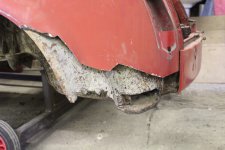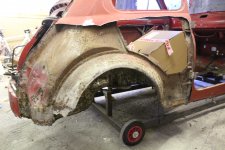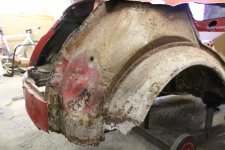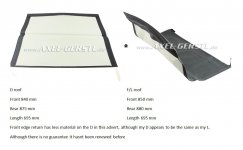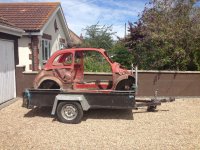I wont be able to get over before then. When you get back I will be in Egypt for 2 weeks so will have to wait until then. Be in touch when I get back.
You are using an out of date browser. It may not display this or other websites correctly.
You should upgrade or use an alternative browser.
You should upgrade or use an alternative browser.
General My next project
- Thread starter Franko500
- Start date
Currently reading:
General My next project
spent an hour or so in the garage tonight.
Cut out some of the heavy corrosion to the nsr 1/4 panel (sill and rear arch area) this will expose the inner panels for sandblasting.
Only problem is I'm still concerned about corrosion between the inner and outer arch that I haven't removed. I didn't really want to fit a whole arch panel as I find this too large a repair for my liking and will use too much filler. I am a firm believer of saving a panel by any means if required, but not if there is a new panel available. Its just the D ones are so much more expensive than the F/L/R.
The osr 1/4 panel was too far gone in terms of corrosion, old impact damage and previous body filler. So its been removed. It needed to come off to repair the inner panels properly.
Its interesting to see that they made the inner arch all one panel along with the inner door frame etc. Yet on the F onwards there must be a good 6 panels used. Strange to think they made the car with a sunroof to save on steel, and yet would have used a massive piece of sheet steel to press the inner and outer side panels. The outer being the rear 1/4 panel, sill, roof rail and front wing.
Sadly I don't think I will find a full D side panel out there, and certainly not for a reasonable price. So I will have to make do with whats available.
Hopefully the shell and parts are going to the blasters Monday
Cut out some of the heavy corrosion to the nsr 1/4 panel (sill and rear arch area) this will expose the inner panels for sandblasting.
Only problem is I'm still concerned about corrosion between the inner and outer arch that I haven't removed. I didn't really want to fit a whole arch panel as I find this too large a repair for my liking and will use too much filler. I am a firm believer of saving a panel by any means if required, but not if there is a new panel available. Its just the D ones are so much more expensive than the F/L/R.
The osr 1/4 panel was too far gone in terms of corrosion, old impact damage and previous body filler. So its been removed. It needed to come off to repair the inner panels properly.
Its interesting to see that they made the inner arch all one panel along with the inner door frame etc. Yet on the F onwards there must be a good 6 panels used. Strange to think they made the car with a sunroof to save on steel, and yet would have used a massive piece of sheet steel to press the inner and outer side panels. The outer being the rear 1/4 panel, sill, roof rail and front wing.
Sadly I don't think I will find a full D side panel out there, and certainly not for a reasonable price. So I will have to make do with whats available.
Hopefully the shell and parts are going to the blasters Monday
Attachments
Bigvtwin996
Established member
- Joined
- Jul 19, 2011
- Messages
- 1,348
- Points
- 430
Something I have heard many times but not having a F/L/R is that the profile of the wings and doors are different...
I in fact have a N with a later front and everything seems to line up...and know a lot of Italians used to buy a later front panel as it was considerably cheaper (not so much now) than the N ones and use that (modified for headlights and horn)
can you check the profiles of the doors and wings?
as I thought the differences could not be much so if you didn't need a full wing you could use the later F rear wings and cut a large section for a repair...
I in fact have a N with a later front and everything seems to line up...and know a lot of Italians used to buy a later front panel as it was considerably cheaper (not so much now) than the N ones and use that (modified for headlights and horn)
can you check the profiles of the doors and wings?
as I thought the differences could not be much so if you didn't need a full wing you could use the later F rear wings and cut a large section for a repair...
Sean's going to know for certain, but those "D" doors look to have a curved profile where they meet the "A"-pillar, which would be messy to rectify even if that is the only difference. But they seem different where they meet the scuttle and if the front panel is different, maybe at that join too?
I see that some suppliers show the "F" front with the hole for the horn noise to get out. Maybe that panel is similar to the "D"? On later "F"s it's actually more accurate to fit an "L" front panel and the plastic "wings" badge fully covers the recess for the badge.
Sean, do you know if the hinge-pins are 6mm diameter please?
I see that some suppliers show the "F" front with the hole for the horn noise to get out. Maybe that panel is similar to the "D"? On later "F"s it's actually more accurate to fit an "L" front panel and the plastic "wings" badge fully covers the recess for the badge.
Sean, do you know if the hinge-pins are 6mm diameter please?
Crikey! You're a glutton for punishment Sean!
I've always thought that Sean is crazy!
Bigvtwin996
Established member
- Joined
- Jul 19, 2011
- Messages
- 1,348
- Points
- 430
I've sent Sean details of his next project... I'm sure he will be tempted....
it would be good to settle the "Profile" discussion, i have heard before....
but if the doors were of a different profile how could my one car have later wings and font panel it would be very noticeable if the profile was that different...
When N front panels were £250 then the Italians would remove the headlight buckets, but the cheapest front panel possible fit the buckets and cut a hole for the horn.. this was quite common, I have pics somewhere...
I can understand that possible where the wings join the door aperture may be different...
but the same 180 degree arch repair can be used on all models as can the rubbish repair inner arches... floor Pans are the same... Bulkheads
but why when fiat were trying to save money would they make a totally different design to basically the same car in changing the profiles there seems to be nothing to gain,, door opening changes were partly an enforced change because of safety...
I await the Master of Rusts response
it would be good to settle the "Profile" discussion, i have heard before....
but if the doors were of a different profile how could my one car have later wings and font panel it would be very noticeable if the profile was that different...
When N front panels were £250 then the Italians would remove the headlight buckets, but the cheapest front panel possible fit the buckets and cut a hole for the horn.. this was quite common, I have pics somewhere...
I can understand that possible where the wings join the door aperture may be different...
but the same 180 degree arch repair can be used on all models as can the rubbish repair inner arches... floor Pans are the same... Bulkheads
but why when fiat were trying to save money would they make a totally different design to basically the same car in changing the profiles there seems to be nothing to gain,, door opening changes were partly an enforced change because of safety...
I await the Master of Rusts response
In answer to your questions Peter...
Its not so much the profiles of the panels, they appear to be very similar.
Front Panel
I believe the front panel hasn't changed in terms of its overall shape or fitment. Main differences are the hole in the front, vents for the N, and different lamp supports - they are deeper than the later ones due to they had the additional lamp base whereas the later ones had the legs built into the lamp.
Front wings
The F onwards are a one piece wing whereas the N/D were part of the full side panel (wing, sill, roof rail & 1/4 panel)
The top of the wing where it joins the scuttle panel is different. As is the inner top wing support. The profile looks similar although it is wider at the top where it meets the scuttle panel.
Indicator holes different for N model.
The main difference is how the wing is attached to the A pillar. The early cars had about 3/4" step which is spot welded to the inner frame around the inner door frame. The later ones have a 3/4" return that butts up against the back of the wider and stronger door post which houses the front door hinges.
Sills
These look basically the same apart from the profile of the step.
The N/D have the 3/4" step welded to the inner frame.
Later ones have a much deeper step.
Whereas the early cars had the outer sill attached to the inner sill and then an additional panel added inside the car to add strength, they changed this to one inner sill panel and then the deeper outer one which provides the extra strength.
1/4 panel
Again very similar profile about 135mm between visible swage lines.
Rear lamp holes are different for N, D and later models.
The rear roof rail is a different profile. no gutter rail over the 1/4 panel and the D has no joint.
Its the front edge that again is different.
The N/D has the 3/4" step welded to the inner frame. And also has the door hinges poking through the panel. They were sealed with a large amount of dum dum (flexible sealer) as found in places around the car. (inner corners of dash, engine bay)
The later ones have the deeper profile continued up from the sill.
Doors
From the exterior they actually look very similar shape.
Although the later ones are about 1/4" wider.
I haven't tried fitting a later door in the hole yet.
The construction is totally different. The early ones had very little strength compared to the later ones. The frame depth is narrower on the early ones. The door skin followed the conventional single skin that had a return lip folded back over the inner frame. The later model changed completely to a process that was probably easier to create without so much remedial work. They still used a inner and outer, but these would just slot over each over and then spot welded. Therefore doing away with the folding process which usually creates a certain amount of distortion to the outer skin that needs attention before paint (anyone who has ever changed a door skin will know what I mean)
Door rubbers
The change of door frame profile and improvements at the time also saw the door rubbers change to a much stronger, flexible and reliable rubber with the hollow middle allowing better compression & seal which also made it easier to close the door.
So there you have it, a little more knowledge of the changes from the early to later models.
Peter the hinge pins were 7mm diameter
Its not so much the profiles of the panels, they appear to be very similar.
Front Panel
I believe the front panel hasn't changed in terms of its overall shape or fitment. Main differences are the hole in the front, vents for the N, and different lamp supports - they are deeper than the later ones due to they had the additional lamp base whereas the later ones had the legs built into the lamp.
Front wings
The F onwards are a one piece wing whereas the N/D were part of the full side panel (wing, sill, roof rail & 1/4 panel)
The top of the wing where it joins the scuttle panel is different. As is the inner top wing support. The profile looks similar although it is wider at the top where it meets the scuttle panel.
Indicator holes different for N model.
The main difference is how the wing is attached to the A pillar. The early cars had about 3/4" step which is spot welded to the inner frame around the inner door frame. The later ones have a 3/4" return that butts up against the back of the wider and stronger door post which houses the front door hinges.
Sills
These look basically the same apart from the profile of the step.
The N/D have the 3/4" step welded to the inner frame.
Later ones have a much deeper step.
Whereas the early cars had the outer sill attached to the inner sill and then an additional panel added inside the car to add strength, they changed this to one inner sill panel and then the deeper outer one which provides the extra strength.
1/4 panel
Again very similar profile about 135mm between visible swage lines.
Rear lamp holes are different for N, D and later models.
The rear roof rail is a different profile. no gutter rail over the 1/4 panel and the D has no joint.
Its the front edge that again is different.
The N/D has the 3/4" step welded to the inner frame. And also has the door hinges poking through the panel. They were sealed with a large amount of dum dum (flexible sealer) as found in places around the car. (inner corners of dash, engine bay)
The later ones have the deeper profile continued up from the sill.
Doors
From the exterior they actually look very similar shape.
Although the later ones are about 1/4" wider.
I haven't tried fitting a later door in the hole yet.
The construction is totally different. The early ones had very little strength compared to the later ones. The frame depth is narrower on the early ones. The door skin followed the conventional single skin that had a return lip folded back over the inner frame. The later model changed completely to a process that was probably easier to create without so much remedial work. They still used a inner and outer, but these would just slot over each over and then spot welded. Therefore doing away with the folding process which usually creates a certain amount of distortion to the outer skin that needs attention before paint (anyone who has ever changed a door skin will know what I mean)
Door rubbers
The change of door frame profile and improvements at the time also saw the door rubbers change to a much stronger, flexible and reliable rubber with the hollow middle allowing better compression & seal which also made it easier to close the door.
So there you have it, a little more knowledge of the changes from the early to later models.
Peter the hinge pins were 7mm diameter
Attachments
-
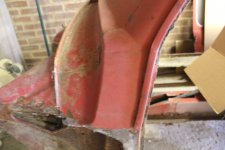 IMG_2106.JPG1.8 MB · Views: 34
IMG_2106.JPG1.8 MB · Views: 34 -
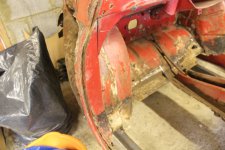 IMG_2105.JPG2 MB · Views: 37
IMG_2105.JPG2 MB · Views: 37 -
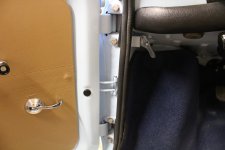 IMG_2104.JPG1.9 MB · Views: 19
IMG_2104.JPG1.9 MB · Views: 19 -
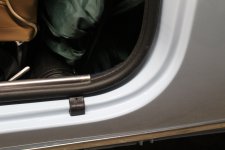 IMG_2103.JPG1.7 MB · Views: 20
IMG_2103.JPG1.7 MB · Views: 20 -
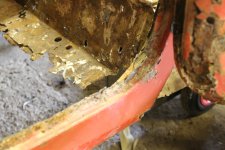 IMG_2102.JPG2 MB · Views: 36
IMG_2102.JPG2 MB · Views: 36 -
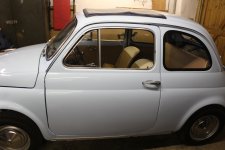 IMG_2111.JPG1.6 MB · Views: 21
IMG_2111.JPG1.6 MB · Views: 21 -
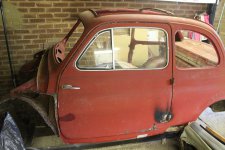 IMG_2110.JPG2.2 MB · Views: 24
IMG_2110.JPG2.2 MB · Views: 24 -
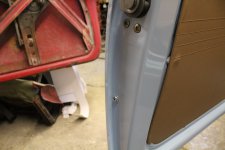 IMG_2109.JPG1.9 MB · Views: 28
IMG_2109.JPG1.9 MB · Views: 28 -
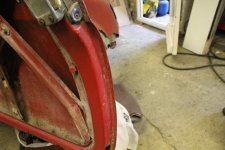 IMG_2108.JPG1.9 MB · Views: 33
IMG_2108.JPG1.9 MB · Views: 33 -
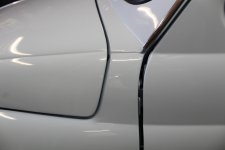 IMG_2107.JPG1.4 MB · Views: 25
IMG_2107.JPG1.4 MB · Views: 25
Bigvtwin996
Established member
- Joined
- Jul 19, 2011
- Messages
- 1,348
- Points
- 430
well that is great Sean....
good job someone advised you to buy that rust bucket...
but be careful as you refer to a Pre (Aug I think) 58 N in some things... as 58 onward the front vents were removed...
very interesting to see the sill differences (I know we have discussed this previously)
the only other thing you missed was the windscreen... the F screen became larger...
however if you say the doors are 1/4" wider....
has this extra 1/4" come at the sacrifice of inner room or is the body 1/4" wider to accommodate this... as the same floors are used on post 58 N's as are used on F's
I have been doing some reading up about things....
and always it was said the front grills were removed from the N because they were the same height as the exhaust pipes so in traffic jams they served to poison the occupants with exhaust fumes, apparently the real reason was new lighting regulations introduced which necessitated the fitment of the round lights above the bumper and thus the removal of the wing lights and their replacement with the round button indicator repeater lights.
with Peter up in Scotland doing his long term Road tests Andrew doing his gasket-less engine testing and all this other knowledge coming in.... soon we will be able to rival the Italians on knowledge...
good job someone advised you to buy that rust bucket...
but be careful as you refer to a Pre (Aug I think) 58 N in some things... as 58 onward the front vents were removed...
very interesting to see the sill differences (I know we have discussed this previously)
the only other thing you missed was the windscreen... the F screen became larger...
however if you say the doors are 1/4" wider....
has this extra 1/4" come at the sacrifice of inner room or is the body 1/4" wider to accommodate this... as the same floors are used on post 58 N's as are used on F's
I have been doing some reading up about things....
and always it was said the front grills were removed from the N because they were the same height as the exhaust pipes so in traffic jams they served to poison the occupants with exhaust fumes, apparently the real reason was new lighting regulations introduced which necessitated the fitment of the round lights above the bumper and thus the removal of the wing lights and their replacement with the round button indicator repeater lights.
with Peter up in Scotland doing his long term Road tests Andrew doing his gasket-less engine testing and all this other knowledge coming in.... soon we will be able to rival the Italians on knowledge...
The reason I didn't mention the windscreen was the same reason as all the other differences.
The list is long.
From a body point of view the only parts the same are:
when I said wider I mean longer - from front to back.
The list is long.
From a body point of view the only parts the same are:
- the bulkhead, although there were differences on the area where the tank sits - different bumps, welded vent tubes/bolted vent tubes.
- floors - although I think the N's had different floor design. The R's had the extra sturdy rails as did the 126.
- dashboards - different holes
- inner arches & front outer arches look the same
- rear floor area & inner arches
when I said wider I mean longer - from front to back.
Bigvtwin996
Established member
- Joined
- Jul 19, 2011
- Messages
- 1,348
- Points
- 430
I think this will be good to keep notes of... I am copying all this and putting into a folder of differences...
The floor changes...
Basically the first series of the N had "flat floors" and minimal padding for the rear (2 seats) according the factory numbers the floors changed at chassis number 058004 (Modification Number: 747), but that would put that at around march 1959 far too late I think...
at the same time the seat floor was lowered to allow thicker sponge for the other occupants.
these details are not covered that well in many of the books etc I have...
any one out there find a copy of
"Stampato N. 110.245
Type 110.140
Fiat 500
Carrozeria/Bodywork
Catalogo Parti Di Ricambio (Spare Parts Catalog)
1st and or 2nd Edition (english) I would like them...
The floor changes...
Basically the first series of the N had "flat floors" and minimal padding for the rear (2 seats) according the factory numbers the floors changed at chassis number 058004 (Modification Number: 747), but that would put that at around march 1959 far too late I think...
at the same time the seat floor was lowered to allow thicker sponge for the other occupants.
these details are not covered that well in many of the books etc I have...
any one out there find a copy of
"Stampato N. 110.245
Type 110.140
Fiat 500
Carrozeria/Bodywork
Catalogo Parti Di Ricambio (Spare Parts Catalog)
1st and or 2nd Edition (english) I would like them...
Peter the hinge pins were 7mm diameter
Thanks for that...I might get some for my van tailgate. You've also comprehensively answered any question that anyone might have about early/late panel differences!
Bigvtwin996
Established member
- Joined
- Jul 19, 2011
- Messages
- 1,348
- Points
- 430
sorry for this.. but that extra 1/4 inch on the doors...
the tech books I have the full width of the cars N-R at 1320mm (other than the models with alloy door trims at 1322).. so how is this extra 1/4" inch on each door accommodated?
the tech books I have the full width of the cars N-R at 1320mm (other than the models with alloy door trims at 1322).. so how is this extra 1/4" inch on each door accommodated?
Okay if you really want to know, your measurements are wrong.
the L door front to back is 940mm
the D door front to back is 930mm
don't ask me where the difference is, they are different style doors, 1/4 panels and wings and I don't have the equipment to do a full accurate measurement.
the L door front to back is 940mm
the D door front to back is 930mm
don't ask me where the difference is, they are different style doors, 1/4 panels and wings and I don't have the equipment to do a full accurate measurement.
Attachments
Bigvtwin996
Established member
- Joined
- Jul 19, 2011
- Messages
- 1,348
- Points
- 430
with you now....
"wider".. I thought the doors were "thicker"
(my measurements were the actual car width...outside door to outside door)
I must have misread your last post...
my apologies.....
"wider".. I thought the doors were "thicker"
(my measurements were the actual car width...outside door to outside door)
I must have misread your last post...
my apologies.....
Last edited:
I'm sure I read someone asking if the roof was a different size. So here's some measurements
D roof
front 840mm, rear 875mm, length 695mm
L roof
front 850mm, rear 880mm, length 695mm
of what I can see from the adverts there maybe a difference in the length of the front return but I cant see it on my D & L but there is no guarantee it hasn't been replaced before.
D roof
front 840mm, rear 875mm, length 695mm
L roof
front 850mm, rear 880mm, length 695mm
of what I can see from the adverts there maybe a difference in the length of the front return but I cant see it on my D & L but there is no guarantee it hasn't been replaced before.
Attachments
Paolo66
Established member
- Joined
- Feb 6, 2013
- Messages
- 1,004
- Points
- 235
Same as last time Damian,
Glass bead
Soda blasting gets the paint off but is not that good at removing rust.
The glass bead blasting was excellent last time. Admittingly I removed virtually all the rusty panels before and only left them with the light rust.
Trouble is I spent ages cleaning rust up, but this time I'm letting them do all the hard work. I have removed the worst panels that I know I will be replacing, cut out the worst of the rust and then they can get the shell clean. It will be nicer to work on & I can weld through the primer they put on.
Really looking forward to getting it back.
Also sending off the following:
Front hub uprights
front drums
rear swinging arms
rear springs
front and rear brake back plates
rear brake drums
gear stick, bracket & the long arm
gearbox support
boot lid
Sump
air intake tube (separate from the car on the D)
Brake & clutch pedal
My blast cabinet is ok for small stuff, but as you know it takes ages, its messy and my compressor doesn't have the same air pressure as they do.
They really get rid of the rust.
Leaves me with just the nice bits to do.
Glass bead
Soda blasting gets the paint off but is not that good at removing rust.
The glass bead blasting was excellent last time. Admittingly I removed virtually all the rusty panels before and only left them with the light rust.
Trouble is I spent ages cleaning rust up, but this time I'm letting them do all the hard work. I have removed the worst panels that I know I will be replacing, cut out the worst of the rust and then they can get the shell clean. It will be nicer to work on & I can weld through the primer they put on.
Really looking forward to getting it back.
Also sending off the following:
Front hub uprights
front drums
rear swinging arms
rear springs
front and rear brake back plates
rear brake drums
gear stick, bracket & the long arm
gearbox support
boot lid
Sump
air intake tube (separate from the car on the D)
Brake & clutch pedal
My blast cabinet is ok for small stuff, but as you know it takes ages, its messy and my compressor doesn't have the same air pressure as they do.
They really get rid of the rust.
Leaves me with just the nice bits to do.
It will be nicer to work on & I can weld through the primer they put on.
We don't have anyone up here who would do that; it would be very handy on a rusty campervan.
How soon is he expected back home?




